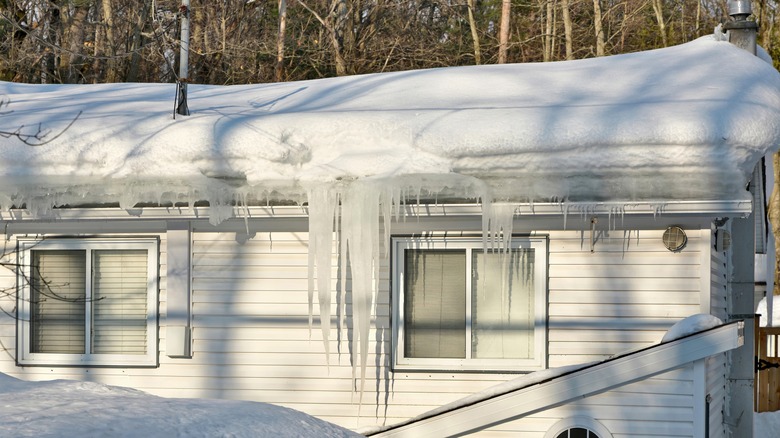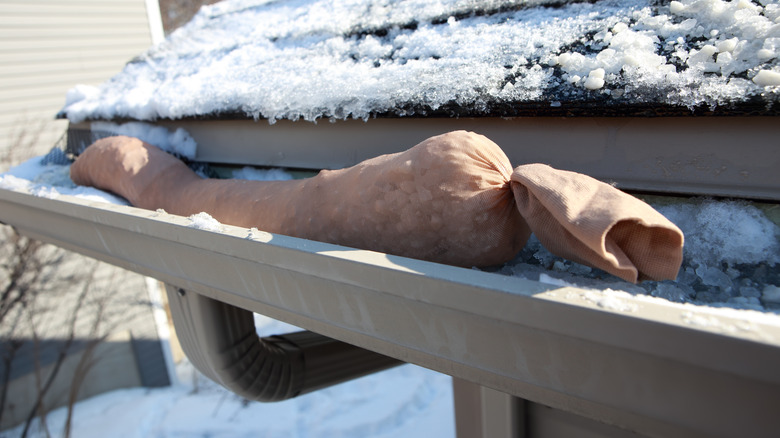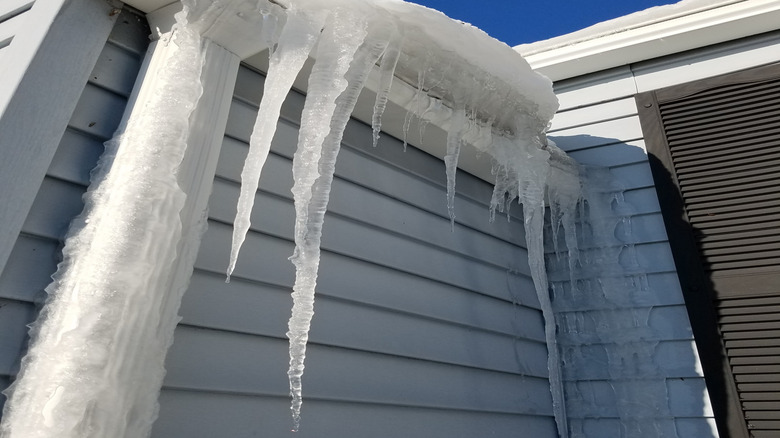The Stocking Hack That Can Help Remove Ice From Gutters
Winter storms bring beautiful snow, but they also bring frozen gutters and ice dams that can lead to expensive home repairs. If you're struggling to figure out how to get rid of ice dams and heavy ice formation, there's a low-tech way to fight back using just two items you probably already have lying around. The solution is to fill old socks or stockings with calcium chloride, also known as ice melt, and put it right on top of the frozen sections of your gutters.
You need to use enough of the ice melt to carve a path through the ice. Make sure you don't use regular rock salt because it doesn't work as well and any salty runoff could kill nearby plants and grass. Another important note: Do not skip the sock. Without the sock acting as a barrier, the ice melt can leave ugly stains on the siding and shingles.
Why is calcium chloride the best choice for de-icing?
Understanding the differences between de-icing options is important when finding out the safest ways to remove icicles from your home. When comparing calcium chloride and rock salt (sodium chloride), the biggest difference is in their ability to work in low temperatures. Rock salt starts to lose its effectiveness quickly once temperatures dip below 15 degrees Fahrenheit, while calcium chloride can melt ice when the temperatures get down to -25 degrees Fahrenheit. Another difference is how they interact with ice. Calcium chloride is exothermic, meaning it makes heat when it mixes with water, which helps it start dissolving immediately and speeds up melting. Studies have shown that calcium chloride can melt ice up to eight times faster than sodium chloride during the first half hour of application.
Sodium chloride doesn't do this, so it melts ice much slower and requires more product. Using rock salt when temperatures are too low often results in a slush that will refreeze, which can make the ice blockage even worse. The saltwater runoff is also corrosive and it can cause damage to metal gutters, flashing, and shingle nails. It can also leave behind a residue that continues to affect these materials long after the snow is gone.
Where to place the ice melt stockings
When looking for the handiest hacks to take care of snow and ice outside, the ice melt sock is a good option. Once you've filled your ice melt sock, putting it in the right spot is important. You want to put it across the ice dam, making sure it goes across the roof's edge. You need to position the sock so one end sits down inside the gutter while the other is a few inches up the lower section of the roof. This hack is effective since the calcium chloride releases slowly. The ice melt crystals inside the fabric that create a concentrated liquid when they touch the frozen water. This liquid has an extremely low freezing point, so it continuously melts the ice right beneath and around the sock.
This steady melting will carve a drainage ditch right through the ice. This lets the water that melts higher up on the roof to flow down safely off the house, which takes the strain off the roof. You should put the socks approximately every 4 feet along the eaves, paying extra attention to spots right over your downspouts or wherever you see the worst ice. You can leave the stockings in place until the danger of freezing weather has passed, or until all the calcium chloride is used up.


